
Sir Sultan Muhammad Shah, Aga Khan III. Photo Copyright National Portrait Gallery, London.
Editor’s note: To mark the 136th birth anniversary of the 48th Ismaili Imam, His Highness the Aga Khan III (1877-1957), which falls on Saturday, November 2, 2013, we are pleased to publish two pieces of first visits made by the Imam to two continents in the span of six years. The first account is by the late Otto Mahnke of the Interment Camp, Norton, Southern Rhodesia (now Zimbabwe). The narrative of the visit to Africa appeared in the Diamond Jubilee Souvenir Yearbook which was published in Dar-es-Salaam in 1946 (cover photo, below), to celebrate Mawlana Sultan Mahomed Shah’s 60 years of Imamat on August 17th, 1945. The souvenir was edited by the late Rai A. M. Sadaruddin, who was the Publicity Officer during the Diamond Jubilee Celebrations. Vazir Abdulla Hassam Ganji was the Special Authority and Officer-in-Charge.
Mahnke’s account is then followed by a compilation of unique images and excerpts from historical American newspapers which reported on the Ismaili Imam’s ‘incognito’ visit to the USA in 1906-1907.
I. 1899: HIS HIGHNESS THE AGA KHAN IN EAST AFRICA

Cover of the Souvenir Issue published to commemorate the Diamond Jubilee of His Highness the Aga Khan III. Image: Sadruddin Khimani Family Collection, Vancouver, Canada
By Otto Mahnke
As I was staying in Bagamoyo in East Africa in August of 1899, when His Highness the Aga Khan set foot on the continent for the first time at Bagamoyo and honoured the Ismaili community, which already counted numerous members at that time, by his visit, I remember very well the following events:
His Highness arrived in his own yacht which anchored at a distance of about four miles from the shore. Thousands of Indians, natives, and also Europeans, of whom there lived only about 20 at Bagamoyo at that time, were waiting on the beach — all wanted to see His Highness and welcome him. Among those present there were also Indians from Zanzibar, Dar-es-Salaam, Sadani, and Pangani.

Partial map of Tanzania, with locations of Bagamoyo and Dar-es-Salaam.
Among the prominent Indians of the Ismaili community, I remember a number by names, and I shall enumerate some of them. Bandali Remtullah as Mukhi was their representative. Others were Alidina Visram, Ibrahim Lila, Kanji Hansraj, the heir of Jan Hansraj, Dhalla Bhimji, Daramsi Haschem, and Jaffer Dossa Thawer, Jaffer Remtullah, Pardan Mohamed, Abdullah Allarakia, Merali Remtullah, Jaffer Somji, Ali Siwji, Ismail Jiwani, Ali Somji, Ibrahim Hasim, Saleh Siwji, and many others.
The enthusiasm and the veneration for His Highness at his arrival, as well as during his whole stay, was tremendous, and will linger in the memories of all who, like me, had the honour to be present. Among other events, His Highness the Aga Khan was received with great honours at the Boma by the Chief of the District, Surgeon-Major Gaertner, and all the Europeans, among them myself.

A stunning view of the Indian Ocean from the roof-top of the Bagamoyo Jamatkhana. Photo: Shariffa Keshavjee, Nairobi, Kenya. Copyright.
The Indian Ibrahim Lila of Zanzibar had sent a cab with a white horse to be placed at the disposal of His Highness so that he might move about the town with great speed. At these drives ovations of the highest veneration took place everywhere; but as soon as His Highness gave an almost imperceptible sign in order to say a few words, absolute silence reigned.
At that time, the chief trade with the interior as far as the three big lakes, and even with the Belgian Congo, was carried on from Bagamoyo, hence most of the trades-people had settled at Bagamoyo even many years before the German government occupied and administered the territory. Mainly they were Indians from the district of Cutch in India, and by far the biggest number of them belonged to the Ismaili community, the smaller part constituting the Ithnasheri under the leadership of Nasser Virji and his brother Kassum Virji. Further, there ‘were two Bohra Indians and some Memons of whom the business of Haji Mussa Allana & Company was the biggest, and some Hindus who worked as gold or shoe fundis (Swahili for craftsmen or artisans).

The Old Boma where His Highness the Aga Khan was received with great honours by the Chief of the District, Surgeon-Major Gaertner, and all the Europeans, among them the author of this piece. The building is one of the oldest standing stone structures in the conservation town of Bagamoyo. The Germans constructed it in 1895 as the German Boma to serve as the colonial administrative headquarters of the first capital of the German East Africa and the residence of the German Colonial Administrator. Owned now by the Tanzanian Government, the Boma is a very attractive structure that commands a clear view of the Indian Ocean. The Old Boma is presently deserted. It is the most notable reminder of the colonial period used by both Germans and British as the first state house of the country. Photo and caption from “Conservation and Maintenance of the Old Boma Building in Bagamoyo” by Dr. Charles Lucian. See link to article, below.
In 1899, there were 401 brick houses in the town of Bagamoyo, belonging almost entirely to members of the Ismaili community. In addition, there were 2431 native houses with makuti roofs, built along streets which were already comparatively straight in those times. Besides, there were two large and magnificent houses which had been given as a present to the German administrative authorities by the Indian Sewa Hadji. Between the old and the new Boma was a house which belonged to a rich Hindu, Ratu, and which had a historical past, inasmuch as from one of its windows the well-known explorer and governor of the Equatorial Province of the Sudan, Emin Pasha, had fallen and badly hurt himself a day after he had arrived at Bagamoyo in the company of the still more famous English explorer and traveller, Henry Stanley, who had liberated him from a mutiny in the Sudan.

A view of the historic town of Bagamoyo, which lies 75 kilometres north of Dar-es-Salaam on the coast of the Indian Ocean. Bagamoyo District is endowed with an extraordinary historical and cultural heritage and was recently designated a United Nations Educational, Scientific, and Cultural Organization (UNESCO) World Heritage Site. This heritage is based on the 19th century slave and ivory trade between the East African inland and the Zanzibar-based sultanate. Caption and Photo: UN-HABITAT, 2009.
I should still like to mention that in the years 1899 and 1900 quarrels existed between the Ismaili community and the followers of Virji, which frequently led to violence and affronts and had to be settled at the Boma. Gradually, however, all this ceased, if I, who lived at Bagamoyo from 1899-1902, remember it right.
I also remember well the appearance of His Highness the Aga Khan, who was at that time about 23 years of age, and if I were an artist, having nothing else to do now, I should have liked to paint a portrait of His Highness. Unfortunately, I possess no longer any photographs of that time, having lost them in the First World War.
I should be pleased if my contribution will be of some use to your purpose. At any rate, these lines have made me live again through the good times with their great and honourable memories. I believe that I am [at the time of writing, 1946 – ed.] the only Bagamoyo European still alive, who saw this memorable visit [of His Highness the Aga Khan] in 1899.
Date posted: Saturday, November 2, 2013.
_________________
II — 1906: HIS HIGHNESS THE AGA KHAN IN THE UNITED STATES OF AMERICA (From the Archives of the United States Library of Congress)
“I have come to America because your country is acknowledged to be the most progressive in the world and I have long wanted to see for myself its successful enterprises and great commercial centers” — His Highness the Aga Khan III (1877-1957)

Library of Congress, Washington, DC. Image: Wikipedia.
Introduced and Compiled by Abdulmalik J. Merchant
Publisher-Editor, Simerg.com
INTRODUCTION: For the first time perhaps, many of our readers will learn about a remarkable and historical journey across America that the 48th Ismaili Imam, His Highness the Aga Khan (1877 – 1957), made during the winter of 1906-1907. Zaheer Dharsee of Toronto, Canada, in his contribution for Simerg’s landmark series I Wish I’d Been There had briefly alluded to the visit when he wrote:
“In December 1906, Sir Sultan Muhammad Shah, 48th Imam of the Shia Ismaili Muslims, arrived in San Francisco and started a two month train journey across the United States. He arrived in New York City in January 1907, and stayed at the St. Regis Hotel. In his Memoirs, His Highness gives a vivid description of New York city in the early 1900’s – ‘the motor car was coming into its own, and was no longer the smelly despised toy it was a decade earlier’.”
How did His Highness the Aga Khan reach San Francisco? What major cities did he then visit? What was the purpose of the visit, and what did the Ismaili Imam seek from the visit? These, as well as other interesting insights about the late Aga Khan’s visit, may be gleaned from the reports and notices which appeared in historical American newspapers dated 1906 and 1907. These newspapers are available under the category of “Historical Newspapers” at the website of the US Library of Congress (LOC, see link at end of article) in numerous formats. We are pleased to share with our readers some pertinent images from a few newspapers as well as corresponding transcripts, which have been prepared from un-edited versions of OCR’d texts at the Library. The LOC is the oldest federal cultural institution in the United States, and has the honour of being the world’s largest library by shelf space and number of books.
1. NOTICES OF HIS HIGHNESS THE AGA KHAN’S ARRIVAL IN HONOLULU AND SAN FRANCISCO
Brief notices about the Ismaili Imam’s arrival in the USA appeared as follows:
-
Honolulu arrival by vessel Hong Kong Maru from the Orient was reported in the March 7, 1907 edition of the Hawaiian Star, see top image in this section;
-
Arrival in San Francisco was noted in the February 12, 1907 edition of the Salt Lake Tribune (Salt Lake City, Utah), see bottom image in this section, the January 23, 1907 edition of the Willmar Tribune (Willmar, Minnesota) and the Bisbee Daily Review.
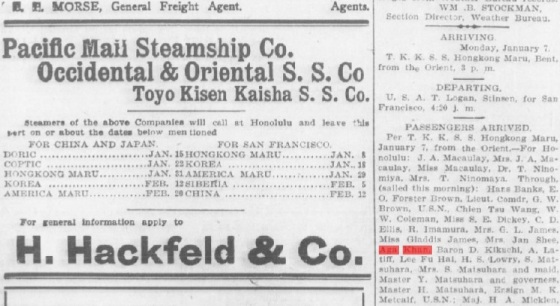
List of passengers who arrived in Honolulu, Hawaii, in the vessel Hong Kong Maru. Many passengers including His Highness the Aga Khan are noted as having sailed through (to San Francisco). Newspaper Image: Library of Congress, USA)
~~~~~~~
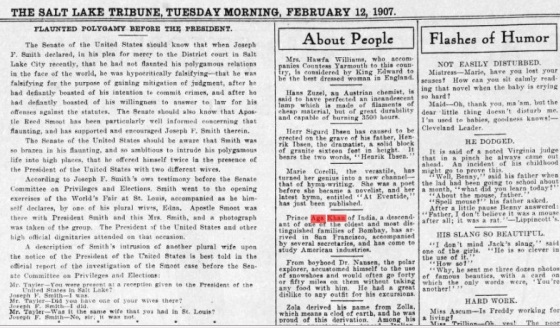
Utah’s Salt Lake Tribute was one of several newspapers in the USA that announced the arrival of Prince Aga Khan to San Fransisco. This cropped image is from the February 2, 1907 edition of the paper. Credit: Library of Congress, USA
________________
2. SULTAN AGA KHAN NOW IN AMERICA
“The Pope and the Dalai Lama of Tibet are great spiritual chiefs, but in them the principle of inheritance is absent” — The Washington Herald
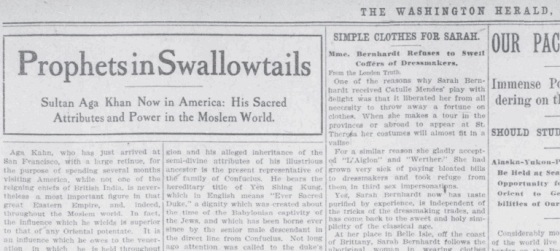
Clip of page from the Washington Herald dated January 27, 1907 containing article on His Highness the Aga Khan. Excerpts of Library of Congress (OCR) transcript appear below. Newspaper Image: Library of Congress, USA.
The following excerpts are taken from the Sunday, January 27, 1907 editions of the Washington Herald and the New York Tribune.
Aga Khan, who has just arrived at San Francisco, with a large retinue, for the purpose of spending several months in visiting America, while not one of the reigning chiefs of British India, is nevertheless a most important figure in that great Eastern empire, and, indeed, throughout the Moslem world. In fact, the influence which he wields is superior to that of any Oriental potentate. It is an influence which he owes to the veneration in which he is held throughout Islam as a direct descendant of the Prophet, from the latter’s daughter Fatima…
….The Pope and the Dalai Lama of Tibet are great spiritual chiefs, but in them the principle of inheritance is absent. The Sultan of Turkey owes his position as one of the leaders of Islam to his possession of great secular power. But the Aga Khan, whose full title is “His Highness Sir Sultan Mahomet Shah Aga Khan, Grand Cross of the Order of the Indian Empire,” is one of the three or four chiefs of a religion by inheritance who are and have been for centuries voluntarily recognized as such by followers in all parts of the world, separated from each other by physical and political conditions and united only in their allegiance. He is without exception the most interesting Oriental who has ever visited the United States….
________________
3. HIS HIGHNESS THE AGA KHAN IN SAN FRANCISCO
“This is my first visit to America, and as I have read much of the wonderful progress and commercial power of the nation, I look forward to an interesting trip.” — His Highness the Aga Khan
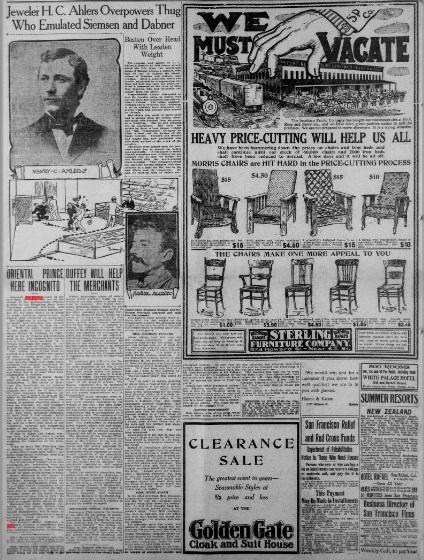
Story under the heading “Oriental Prince Here Incognito” (highlighted, left column) in the January 15, 1907 edition of “San Francisco Call” includes remarks by His Highness the Aga Khan. Transcript is produced below from US Library of Congress OCR’d text. Newspaper Image: Library of Congress, USA.
“ORIENTAL PRINCE HERE INCOGNITO”
Mahomed Aga Khan, cousin of the late Shah of Persia and one of the richest of the Mohammedan Princes, arrived on the Hongkong Maru from Yokohama yesterday afternoon, and will leave on the overland limited to-day for the East, where he is going to study American manufactures in general and electricity in particular.
…. With his suite, which consists of two dusky “clerks” and his intimate friend, R. Talamon, he registered at the St. Francis and consumed most of the time between his arrival and 6 o’clock, when he went to a Preach restaurant for dinner.
In the evening he attended the opera. The Prince was attired when he arrived in a stylish brown suit, topped off with a nobly gray cap. He is of commanding figure, with aquiline nose, piercing black eyes, large black mustache and swarthy complexion. He speaks English with a French accent, having been educated in London and Paris, and is at least while here, unassuming in conduct. “As I am trying to travel incognito,” he said, “I do not care to be interviewed. I like rather to interview the Americans, as my mission here is to study their manufacturing methods and their use of electricity.”
“You have numerous waterfalls in your country, and I intend to stop at Niagara to familiarize myself with their project for harnessing the waters, to produce electrical power. I have no itinerary, but will probably stop three days in Chicago and then visit two or three cities between there and New York, including Pittsburg.
“In New York I will be about two weeks, and then proceed to London. This is my first visit to America, and as I have read much of the wonderful progress and commercial power of the nation, I look forward to an interesting trip.
“I was in Japan just before coming, here, and while there I called on the Mikado and spent a few weeks studying the industries of his kingdom. I am so sorry San Francisco was so terribly visited last spring. What a great city it must have been. I see many magnificent buildings remaining where the fire swept.
“I have talked enough. That is all.”
The Prince’s two “clerks,” as he calls his attendants are secretaries, who jot down for future reference the results of his observations, so that, he may benefit by them on his return to India.
Prince Mahomed is well-known in Europe, where he has traveled extensively. Although but 31 years old he has many distinguished titles. He is a Knight Grand Commander of the Indian Empire, and received the Brilliant Star of Zanzibar in 1900. The Prussian Order of the Royal Crown was conferred upon him in 1901. He attended the coronation of King Edward as a guest of the nation in 1902. Mahomed has many religious followers in East Africa, Central Asia and India, being the head of the Ismaili Mahomedans; but in spite of his elite responsibilities, he is a great sportsman, being devoted to golf, cycling and motoring.
The Prince’s official residence is Aga Hall, Bombay, a magnificent palace of’ the Oriental style, but he has also handsome residences in Calcutta, London and Paris.
_______________
4. HIS HIGHNESS THE AGA KHAN PASSING THROUGH DENVER
From the January 19, 1907 edition of the New-York Tribune, New York [N.Y.]
Denver, Jan. 18. — “Tut, tut, some people are mighty squeamish on the subject of clothes. Why isn’t a suit of nice pajamas just as conventional as a full dress make-up?” demanded the secretary of Prince Mahomet Aga Khan, cousin of the late Shah of Persia, when their train passed through Denver to-day. It was all about the prince appearing in a dining car attired in a gorgeous suit of pajamas. Americans in the car, not alive to Persian eccentricities, demanded that the prince put on more clothing, but he refused, and was allowed to eat his breakfast in peace….From OCR’d text, Library of Congress, USA
_______________________
5. HIS HIGHNESS THE AGA KHAN IN CHICAGO
All the way across the continent I saw only snow, snow. One vast blanket of white seems to cover the whole country to the westward” — His Highness the Aga Khan
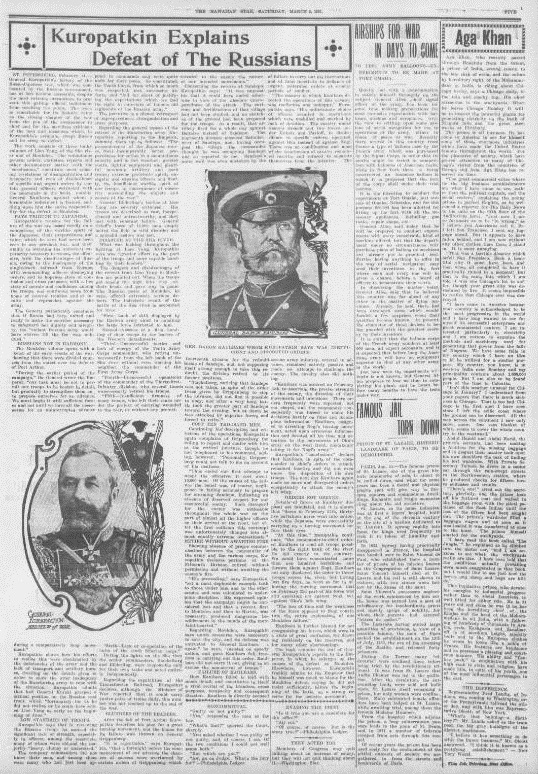
Hawaiian Star, March 2, 1907 Page 5, last column reports Aga Khan’s Chicago visit. Transcript is produced below from US Library of Congress OCR’d text. Newspaper Image: Library of Congress, USA.
“AGA KHAN”
Aga Khan, who recently passed through Honolulu from the Orient, a prince of India, second cousin to the late shah of Persia, is riding about Chicago to-day, says a Chicago daily, in the rain and smoky fog. His chief attraction is the stockyards. When he leaves Chicago Monday it will be to inspect the powerful plants for generating electricity on the bank of Niagara Falls and the great steel works at Pittsburg.
The prince is all business. He has come to America to see for himself some of those enormous industries which have made the United States famous throughout tho world. For the pleasures of society, which have proved attractive to many of Chicago’s visitor from the countries of Europe and Asia, Aga Khan has reserved no time.
“The great commercial cities where lie the big business establishments are what I have come to see, rather than the political capitals, and the social centers,” explained the young prince in perfect English, as he welcomed a reporter for The Daily News to his suite on the fifth floor of the Auditorium hotel. “Just now I am so fortunate as to be ‘in wrong,’ as I believe you Americans call it. Before I left San Francisco, I sent my luggage ahead. But it appears to have fallen behind, and I am now without any other clothes than those I stand in. It is most annoying.”
“That was a horrible disaster which befell San Francisco. Such a beautiful, city it must have been, and then when all completed, to have it practically ruined in a moment! But that is the same fate which I am told it was one Chicago’s lot had to suffer, though your great city was devastated by fire. It seems impossible to realize that Chicago ever was destroyed.
“I have come to America because your country is acknowledged to be the most progressive in the world and I have long wanted to see for myself its successful enterprises and great commercial centers. I am interested particularly in electricity and I am curious to examine the methods and machinery used for generating that power from the falls of Niagara. We have some falls in my country which I have an idea could be utilized for a similar purpose. My county, you know, is in western India near Bombay and my principality contains about 1,000,000 people. But I am also to be found part of the time in Calcutta.
“Isn’t this weather unusual for Chicago in January? I understand from your papers that there is much sickness in Chicago. That is too bad. Chicago is the first spot I have seen since I left the Pacific coast where the ground can be discerned. All the way across the continent I saw only snow, snow. One vast blanket of white seems to cover the whole country to the westward.”
Abdul Hamid and Abdul Harid, the prince’s servants, had been making a fruitless [search] for the missing baggage and in disgust their master took upon his own shoulders the task of finding his lost wardrobe. With Private Secretary Talmon he drove in a motor car through the rain-swept streets to the Northwestern station, where he produced checks for fifteen boxes of suitcases and trunks.
“There’s one!” cried out the secretary, gleefully, and the prince took off his fur-lined coat and waited in the baggage room with the stoical patience of the East Indian until the last of the fifteen had been sought out. The prince’s wardrobe filled a baggage wagon and as soon as it was loaded it was transferred at once to the hotel. The Prince himself started for the stockyards. “I have read the book called The Jungle,” he explained as he climbed into the motor car, “and I am anxious to see what the stockyards really are like. I have been told that the conditions actually prevailing were much exaggerated in that book, but I would like to see just how the beeves and sheep and hogs are killed.”
This inquisitive prince, who devotes his energies to industrial progress rather than to social function is well fitted for either role. He is 31 years old and since he was 10 he has been the hereditary chief of the Khojas…He is of medium height, stockily built and in the European clothes he wears he looks like a noble of France. His features are handsome and he possesses a pleasant and courteous manner. His ability and ‘Yankee Push’ in conjunction with his high rank in state and religion, have made him, in spite of his youth, one of the influential personages in the east.
~~~~~~~~
6. HIS HIGHNESS THE AGA KHAN DEPARTS FOR EUROPE

A portrait of Sir Sultan Mahomed Shah, His Highness the Aga Khan III, dated 1911, a few years after his historic USA visit. Copyright: National Portrait Gallery. London.
The following is from the January 19, 1907 edition of the New-York Tribune, New York [N.Y.]
Among the passengers who sailed yesterday for Europe on the Teutonic was Sultan Aga Khan, one of the most notable figures in India, and indeed, throughout the Moslem world, by reason of his direct descent from Mahomet through the latter’s daughter Fatima.
Date Posted: Saturday, November 2, 2013 (the USA visit piece is a repost from November 11, 2012).
Copyright: Simerg.com
________________
We invite our readers to visit the Library of Congress Website. Please click www.loc.gov, and discover the library’s rich and diverse collection.
Also see The Conservation of the Old Boma Building in Bagamoyo by Dr. Charles Lucian of the School of Real Estate Studies, Ardhi University.
We welcome feedback/letters from our readers. Please use the LEAVE A REPLY box which appears below OR send your comment to Simerg@aol.com. Your feedback may be edited for length and brevity, and is subject to moderation. We are unable to acknowledge unpublished letters. Please visit the Simerg Home page for links to new and recent posts. For chronological links to articles posted on this Web site since its launch in March 2009, please click What’s New.

Wonderful souvenir and beautiful picture of when He was very young. Such a detailed account of His visits. I am truly so grateful for all of this information.
A true record of History. The little quotes that the Editor has included about Dalai Lama and the Pope not being hereditary are also not to be overlooked as the Imam of Shia Ismailis are hereditary and this is about the late 48th Imam’s journey to East Africa and USA.
What a piece of historical evidence? I have seen the Souvenir of Diamond Jubilee that my family had and I suspect I brought it with me to UK as I was joining University of Oxford in 1967. The details of Bagamoyo and Dar-es-Salam are very significant, the latter is where my family and I celebrated the event of Hazrat Sultan Muhammad Shah’s weighing against diamonds that I viewed as a child. I still can picture it today!
The Editor of http://www.simerg.com is remarkable!
I just loved Otto Manhke’s account about the 48th Imam’s first steps in East Africa from the Diamond Jubilee Souvenir. How lucky for us that a copy exists. I just loved the art work on the cover. I make a point in my book that the early settlement of East Africa was spearheaded by Khojas (then undifferentiated between Ithnasheris and Ismailis). Sewa Haji Paroo and Allidina Visram (cited by Mahnke as present in the welcome committee) came out to East Africa already at the time of our 46th Imam Hassanali Shah. The Aga Khan family’s ties with the British Raj played a role.